| Pages:
1
..
37
38
39
40
41
..
60 |
watson.fawkes
International Hazard
    
Posts: 2793
Registered: 16-8-2008
Member Is Offline
Mood: No Mood
|
|
Quote: Originally posted by Magpie  | | The results bring up more questions. Like, what difference can be attributed to thorough grinding together in a mortar vs a light grinding in a
mortar. The better performers might just have a less complete reaction. It is impossible to say what is best without knowing the yield of P for each
formulation. This suggests that a different line of further testing is needed. |
Really interesting photo
there. Good call on transparent thimbles; it's much easier to see what's happening. There are culture tubes that come already in about the size you
got by modifying; they seem to come in boxes of 200. You might also consider a ceramic marking pencil that will fire on permanently at temperature.
The first thing that strikes me is the relative difference between 1 vs. 2 and 3 vs. 4. Start with color differences, particularly in the 3-4 pair.
Based only on color it's possible that #3 reacted the most, converting dark Al to light Al2O3. The coarser formulations have
obvious pores and entrained volumes. The idea that this might be due to reaction times and degree of completion seems worth investigating.
One of the ways of testing for completeness of reaction would be to grind and lixiviate the samples with water and see how much soluble content
remains in them. You'd have to distinguish between phosphate and chloride in the leachate. Perhaps then follow with something to preferentially
dissolve unreacted Al.
As an alternate way of testing the amount of P formation, perhaps use a phosphorus getter above a glass wool plug. Use something that reacts
completely with gas-phase P, maybe forming a phosphide, but scavenging all the P formed. Mass difference gives a direct reading of yield.
Seeing these samples has spurred some new ideas about additives. Principal are the constituents of soda-lime glass, oxides and carbonates of sodium,
calcium, and magnesium. Looking at the samples leads me to think that the sooner you get into a liquid-phase reaction, the better off the reaction
will be. Lead oxide would lower melting points, but it would reduce along with the phosphorus. I doubt you'd need bulk liquid, but some interfacial
liquid on particle surfaces might be enough.
The other "additive" that comes to mind is a candidate reagent: calcium carbide. It seems to me it would be an excellent oxygen scavenger in this
environment, lower melting points, and provide some mechanical sparging by CO2 production. Wouldn't need much, I'd guess, to be active at
the beginning of the reaction.
|
|
|
Magpie
lab constructor
    
Posts: 5939
Registered: 1-11-2003
Location: USA
Member Is Offline
Mood: Chemistry: the subtle science.
|
|
Quote: Originally posted by watson.fawkes  |
There are culture tubes that come already in about the size you got by modifying; they seem to come in boxes of 200. You might also consider a ceramic
marking pencil that will fire on permanently at temperature.
|
Readymade tubes would be convenient if I end up doing much more of this. Marking the tubes was a challenge. I made score marks with a file to number
them.
Quote: Originally posted by watson.fawkes  |
The first thing that strikes me is the relative difference between 1 vs. 2 and 3 vs. 4. Start with color differences, particularly in the 3-4 pair.
Based only on color it's possible that #3 reacted the most, converting dark Al to light Al2O3. The coarser formulations have
obvious pores and entrained volumes. The idea that this might be due to reaction times and degree of completion seems worth investigating.
|
Yes, those color and pore volume differences are striking. There's a story there for sure. At first I thought the light pinkish color of #3 was due
to red P. But I think your explanation is more plausible.
I took the picture below this morning by turning off the hood fluorescent light and using a flash:
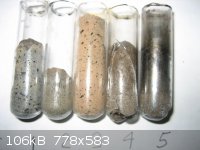
P slags 2
Quote: Originally posted by watson.fawkes  |
One of the ways of testing for completeness of reaction would be to grind and lixiviate the samples with water and see how much soluble content
remains in them. You'd have to distinguish between phosphate and chloride in the leachate. Perhaps then follow with something to preferentially
dissolve unreacted Al.
|
I wished I had weighed the tubes+powder before firing. Then I could weigh them now and determine a weight loss. This could give an indication of
completeness of reaction. But it still does not give a direct indication of useable product, ie, drops of P in the receiver. I'm afraid this will
only be possible with a full scale test.
During this very small scale screening test no drops of P fell into the receiver. The only product I saw was smoke. This is telling me that a
significant loss of yield may be due to aerosol formation (smoke) that does not coalesce in the EMT condenser.
Quote: Originally posted by watson.fawkes  |
As an alternate way of testing the amount of P formation, perhaps use a phosphorus getter above a glass wool plug. Use something that reacts
completely with gas-phase P, maybe forming a phosphide, but scavenging all the P formed. Mass difference gives a direct reading of yield.
Seeing these samples has spurred some new ideas about additives. Principal are the constituents of soda-lime glass, oxides and carbonates of sodium,
calcium, and magnesium. Looking at the samples leads me to think that the sooner you get into a liquid-phase reaction, the better off the reaction
will be. Lead oxide would lower melting points, but it would reduce along with the phosphorus. I doubt you'd need bulk liquid, but some interfacial
liquid on particle surfaces might be enough.
The other "additive" that comes to mind is a candidate reagent: calcium carbide. It seems to me it would be an excellent oxygen scavenger in this
environment, lower melting points, and provide some mechanical sparging by CO2 production. Wouldn't need much, I'd guess, to be active at
the beginning of the reaction. |
Lots of good ideas here. Thanks.
The single most important condition for a successful synthesis is good mixing - Nicodem
|
|
|
watson.fawkes
International Hazard
    
Posts: 2793
Registered: 16-8-2008
Member Is Offline
Mood: No Mood
|
|
Quote: Originally posted by Magpie  | Marking the tubes was a challenge. I made score marks with a file to number them.
[...]
During this very small scale screening test no drops of P fell into the receiver. The only product I saw was smoke. This is telling me that a
significant loss of yield may be due to aerosol formation (smoke) that does not coalesce in the EMT condenser. |
Here's the marking device I had seen for glass:
Ti-Pen at manufacturer Aspen Glass
Ti-Pen at Wale Apparatus
I don't know if it's just a rod of Ti, sharpened and mounted, or whether it's some Ti alloy.
Searching for "borosilicate culture tubes", I found this page from VWR LabShop. They sell the 5 ml tubes, 12 x 75 mm, for about USD 31 for a package of 1000. I put the link here because there are number of other
people working on process parameters who could benefit from some combinatorial testing. The point is that little glass tubes are comparable to cost of
the reagents and can be considered expendable.
If you're getting smoke as a product, and you're purging with argon first, the only sources of oxygen to make P2O5 smoke are
going to be (1) interstitial atmosphere left over within the powder of the charge, or (2) from within the charge itself, either the phosphate or the
silica. There's just not much oxygen (in molar terms) in residual atmosphere to see very much smoke. This leads me to think that an overly high
temperature might first reduce and liberate phosphorus and then reoxidize it in a gas-solid process. Two thoughts on how to deal with this. (a) Lower
the temperature. (b) Add a bit of carbon. Some of the carbon will oxidize to CO. As a gas, will would react away any oxygen available at solid
surfaces. The Al in the charge would would reduce CO and CO2 thus formed. (See the great Al + dry ice combustion video.) In this way carbon is acting
in a catalytic cycle, with the advantage that it's gaseous for part of the cycle.
|
|
|
Magpie
lab constructor
    
Posts: 5939
Registered: 1-11-2003
Location: USA
Member Is Offline
Mood: Chemistry: the subtle science.
|
|
I did not purge with argon first...possibly a mistake. I did use argon for the bubbler as usual for preventing suckback.
The single most important condition for a successful synthesis is good mixing - Nicodem
|
|
|
Rogeryermaw
National Hazard
   
Posts: 656
Registered: 18-8-2010
Member Is Offline
Mood: No Mood
|
|
just an observation but, with your given conditions (meaning the retort of course) i would think that mix #2 would be where i would start. i really am
not sure how NaCl affected my experimentation, but when i used it, i did not achieve that pinkish color. i wonder if there is a dissociation of the
chloride ion at your temps that could allow for a reaction causing impure phosphorus.
with a boiling point of over 1400C dissociation is not the cause but perhaps the phosphorus vapor and chloride undergo some sort of replacement
reaction leaving the sodium to react with??? oxygen from the phosphate? it is more reactive than aluminum. hmmm. something to think about. perhaps the
some of the phosphorus would react with the sodium were that the case. there are several known compounds of phosphorus and sodium.
[Edited on 12-9-2012 by Rogeryermaw]
|
|
|
Magpie
lab constructor
    
Posts: 5939
Registered: 1-11-2003
Location: USA
Member Is Offline
Mood: Chemistry: the subtle science.
|
|
I have added a snorkel to my condenser design. This will allow a greater fill and thus a greater yield. It is being "burnt-in" as I write.
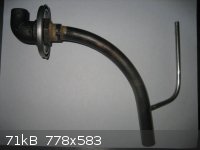
[Edited on 12-9-2012 by Magpie]
The single most important condition for a successful synthesis is good mixing - Nicodem
|
|
|
Magpie
lab constructor
    
Posts: 5939
Registered: 1-11-2003
Location: USA
Member Is Offline
Mood: Chemistry: the subtle science.
|
|
Yesterday I made a full scale production run using the basic (stoichiometric) NaPO3/Al/SiO2 formulation. Ingredients were thoroughly ground together
in a mortar then dried for an hour in an oven. The charge, which weighed 54.4g, was placed in the retort and the condenser installed, the whole
system having been backfilled with argon. The assembly was weighed at 368.8g. The retort void cavity had been measured at 225mL. The assembly was
placed in the oven and the thermostat set for 700C.
At ~500C some smoke, burning phosphine, and drops of white P (very clean and white) were emitted from the condenser. Some white smoke was emitted
from the crack above the furnace door indicating a small breach of containment of the retort. Heating was continued until the furnace temperature
reached 700C. A picture of the P in the receiver is shown below:
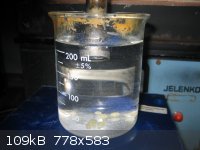
base formulation P (54.4g charge)
When cooled the retort was removed from the furnace. Some white powder, P2O5 I presume, could be seen at the can rim in 2 places, and red P in 4
places. Upon opening the can the slag formation was observed as shown below:
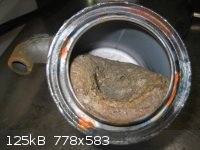
base formulation slag (54.4g charge)
Weight of the fired retort assembly was 367.6g indicating a loss in weight of 368.8-367.6 = 1.2g. The volume of slag was measured by backfilling with
sand to be 166mL. Therefore the slag volume/g of charge = 166mL/54.4g = 3.1mL/g, which exactly matched that of the 1g test tube measurement!
The P produced was a disappointing 0.9g for a %yield of only 9.5%. I expected 19-20%. This weight was close to that shown in the assembly weight loss
of 1.2g computed above, however. Therefore, it seems that the overwhelming contribution to poor yield is just the nature of the reaction itself.
Comments, questions, recommendations?
The single most important condition for a successful synthesis is good mixing - Nicodem
|
|
|
learningChem
Hazard to Others
  
Posts: 182
Registered: 21-7-2011
Member Is Offline
Mood: No Mood
|
|
I got a question...
Isn't the reaction self-sustaining? Shouldn't the ingredients react on their own, once 'ignited'? It should be possible to only heat a small portion
of the retort, to kick start the reaction, and then wait a few seconds for it to complete?
|
|
|
Magpie
lab constructor
    
Posts: 5939
Registered: 1-11-2003
Location: USA
Member Is Offline
Mood: Chemistry: the subtle science.
|
|
Quote: Originally posted by learningChem  | I got a question...
Isn't the reaction self-sustaining? Shouldn't the ingredients react on their own, once 'ignited'? It should be possible to only heat a small portion
of the retort, to kick start the reaction, and then wait a few seconds for it to complete? |
I think that is a possibility. In my experience it seems to fire off at about 500C. The P shows up over a period of a few seconds. It might be
possible to just fire off the reactants using a Bunsen or Meker burner.
The single most important condition for a successful synthesis is good mixing - Nicodem
|
|
|
BromicAcid
International Hazard
    
Posts: 3227
Registered: 13-7-2003
Location: Wisconsin
Member Is Offline
Mood: Rock n' Roll
|
|
Great work Magpie. Although the numbers don't look exciting I think your work is very valuable. It never seemed like the yields were quite where you
would expect and it's great to finally see a true mass difference and percent yield along with information on the expansion of the reaction mixture.
Great work and very concise!
Still, a disappointment from a preparative route. I would have never thought it was that low and you have given the reaction every benefit you could
think of. Oh well, back to the drawing board, right?
|
|
|
Rogeryermaw
National Hazard
   
Posts: 656
Registered: 18-8-2010
Member Is Offline
Mood: No Mood
|
|
that would depend on the viscosity of the melt. it is quite possible that the reactor may need to be held at a temperature to keep the melt fluid so
any phosphorus produced can be released from it.
|
|
|
Magpie
lab constructor
    
Posts: 5939
Registered: 1-11-2003
Location: USA
Member Is Offline
Mood: Chemistry: the subtle science.
|
|
Thank you Bromic. Yes, I hope that by modifying the formulation and/or technique that the yield can be significantly increased.
The single most important condition for a successful synthesis is good mixing - Nicodem
|
|
|
watson.fawkes
International Hazard
    
Posts: 2793
Registered: 16-8-2008
Member Is Offline
Mood: No Mood
|
|
Quote: Originally posted by Magpie  | | Yes, I hope that by modifying the formulation and/or technique that the yield can be significantly increased. |
I went and read the Kirk-Othmer article on white P production. It's mostly about primary extraction from phosphate ores, principally
fluorapatite, so there's CaF2 in the product. The reaction mixture also includes silica and carbon. Some of the silica comes from the ore,
but some is added. The reasons listed are two: (1) thermodynamic favorability from the formation of calcium metasilicate CaSiO3, and (2)
lowering of the slag melting temperature. The temperatures given are as follows: the reaction starts at 1100 °C, the sweet spot is 1400
°C - 1600 °C, and unwanted side reactions (such as reduction of silica) become problematic at 1700 °C. Phosphorus comes off as
the dimer P2, which is favored above 800 °C gas temperature, condensing to P4 below that temperature. (This is
significant because this gas-phase condensation induces ΔP in the exhaust path.) Carbon monoxide is the carbon product, which is unreactive
with P2 and P4 in the exhaust gas.
You, however, are not doing primary extraction. Starting with calcium phosphate should be considered a secondary extraction process. Sodium phosphate,
though, looks to be a better starting material, or perhaps a good additional starting material, at least on the grounds of its lower-melting mixtures.
It seems that the use of Al as a reducer is one of the problems, since alumina forms high-melting slags (stovetop glass cookware is aluminosilicate
glass). Silica seems worth keeping, since it's a good slag-forming material. The liquidus temperature of soda-lime glasses are in the 1000 °C
- 1100 °C range, though. I should also mention that we don't really care whether the slag forms a glass in its solid phase, though many
considered here do.
I found a downloadable spreadsheet for estimating liquidus temperatures on this page on glass properties. A bit of dinking around with it found an approximate minimum at the mixture SiO2 75 wt% +
Na2O 25 wt%, yielding a liquidus temperature of 785 °C. (The temperature rises very quickly with decreasing Na content, much less
so in the other direction.) Small additions of the oxides of Mg, K, Al, and Ca all raised the temperature. From what I can tell, this spreadsheet is
interpolating between measurement data, and I can't vouch for its accuracy.
I don't have handy data for the heat of formation of the various metasilicates, and liquidus point is not the only factor to consider. Nevertheless,
this 3:1 oxide-weight ratio seems like a decent place to start at the thimble scale.
Also, I've realized that chloride flux materials are probably not a good idea, since they may well form PCl3 as a byproduct, which in this
case would be a contaminant.
|
|
|
Strepta
Harmless

Posts: 44
Registered: 6-5-2004
Member Is Offline
Mood: No Mood
|
|
Magpie: "The P produced was a disappointing 0.9g for a %yield of only 9.5%. I expected 19-20%. This weight was close to that shown in the assembly
weight loss of 1.2g computed above, however. Therefore, it seems that the overwhelming contribution to poor yield is just the nature of the reaction
itself. "
I agree and more specifically the likely result of reacting materials in the solid phase. Under the best of circumstances, the proximity and
stoichiometry of the reactants in the neighborhood of the flame front is poor at or anywhere near the molecular level. As with black powder, better
incorporation (mixing of reactants) may be the shortest path to higher reaction yield.
Also, have you experimented with boron trioxide? Since it begins to flow short of the reaction onset temperature, it's possible that holding the
charge at its melting point for an extended time prior to raising the temp to the reaction point may be beneficial. Perhaps use a stoichiometric
excess of B2O3 to facilitate flow?
[/rquote]
[Edited on 20-9-2012 by Strepta]
|
|
|
Magpie
lab constructor
    
Posts: 5939
Registered: 1-11-2003
Location: USA
Member Is Offline
Mood: Chemistry: the subtle science.
|
|
Thank you watson for this research - much food for thought here. I have been doing some reading on steel making slag, which also is loaded with
potential insights. I will post links and discuss it later.
Run #4
Another run was completed recently using the same NaPO3/Al/SiO2 formulation as the previous run except that the NaPO3 was pre-ground for 1 minute, a
teaspoon at a time, in a coffee grinder. The ingredients were then mixed, without grinding, in a mortar.
Although the 1g test tube run (TT#2) indicated a slag volume of 2.1mL/g of charge, I was suspicious that this was too low. So I conservatively chose
a charge size of 60.4g.
As before the charge fired off at about 510C and was complete in a minute or two. It was slower than the previous run. The yield was 1.7g of P for a
% yield of 16.1%. The slag volume was 2.9mL/g, confirming my suspicion. This left a free volume of only 48mL in the retort. So it seems that 60.4g
is a practical maximum charge size.
Weight loss of the assembly due to firing = 375.1g – 373.1g = 2.0g
Discussion
The reaction takes off when reaching sufficient temperature (~500C). The yield might be improved by slowing down the reaction. The obvious way to do
this would be to add an inert substance. If that substance were also a viscosity reducer, all the better, it would seem. A less active reductant
than aluminum might help also.
If this run can be taken as typical then the P reports as follows:
a. drops of white P in the receiver: 16.1%
b. PH3 & P2O5 exiting the condenser: 2.8%
c. tied up in the slag: 81.1%
The single most important condition for a successful synthesis is good mixing - Nicodem
|
|
|
Magpie
lab constructor
    
Posts: 5939
Registered: 1-11-2003
Location: USA
Member Is Offline
Mood: Chemistry: the subtle science.
|
|
Thanks for your comment Strepta. Because we posted simultaneously I almost missed it.
Quote: Originally posted by Strepta  | [...
As with black powder, better incorporation (mixing of reactants) may be the shortest path to higher reaction yield.]
|
Even though the reaction is over with in at most a couple minutes, I understand that we are dealing with possibly a solid/solid/solid reaction,
without benefit of mixing, and that this hinders the reaction at the molecular level. I can possibly improve this somewhat by mixing all ingredients
in the coffee grinder, if it doesn't catch on fire!
Quote: Originally posted by Strepta  |
Also, have you experimented with boron trioxide? Since it begins to flow short of the reaction onset temperature, it's possible that holding the
charge at its melting point for an extended time prior to raising the temp to the reaction point may be beneficial. Perhaps use a stoichiometric
excess of B2O3 to facilitate flow?
|
I have been thinking some of substituting B2O3 for SiO2 myself. I think it would be well worth trying.
[Edited on 20-9-2012 by Magpie]
The single most important condition for a successful synthesis is good mixing - Nicodem
|
|
|
learningChem
Hazard to Others
  
Posts: 182
Registered: 21-7-2011
Member Is Offline
Mood: No Mood
|
|
| Quote: | | tied up in the slag: 81.1% |
So, in theory there is elemental P in the slag? If you break off bits of it, you should see white fumes for instance? Does that actually happen?
Assuming there is P in there, shouldn't it be possible to extract it somehow?
|
|
|
watson.fawkes
International Hazard
    
Posts: 2793
Registered: 16-8-2008
Member Is Offline
Mood: No Mood
|
|
At least in some runs in the
past, there doesn't seem to have been. But your comment did spark an idea.
It's not like you should expect any free P given the reaction mixture. Si, Al, and P all form oxide polymers, heavily cross-linked in the manner of
ceramics. If I had to guess, but with some evidence from Magpie's pictures, I'd guess that the residuum is a mixed suboxide foam. So here's the idea,
making more (potential) work for Magpie. Roasting the slag in an excess of oxygen, after grinding, might show a mass increase as the ordinary oxides
form. Now this is a gas-solid diffusion reaction, so it would require a very fine grind in the powder, high temperature, a reasonable amount of time,
some flow of atmosphere to provide makeup oxygen, and a refractory boat preferably made of an oxygen-saturated ceramic.
It's something still of a mystery as to where all the P ends up, but such an assay might allow an estimate of trapped P. To make the estimate, you'd
assume that all the Al oxidized and that none of the oxygen became volatile. These assumption probably aren't perfect, but it might indicate
something.
|
|
|
Magpie
lab constructor
    
Posts: 5939
Registered: 1-11-2003
Location: USA
Member Is Offline
Mood: Chemistry: the subtle science.
|
|
I concur with watson's assesment that the P is most likely chemically bound as one or more oxides. Just where the oxygen originates is a bit of a
mystery as the retort was backfilled with argon and kept under a slight argon overpressure.
When the slag is cracked open there is no smoking, which would be evidence of free white P. Also there is not much evidence of free red P except some
obvious spots here and there. The beige coloration may be due to finely divided red P, however.
Shown below are two pictures that I just took of the slag from Run#4:
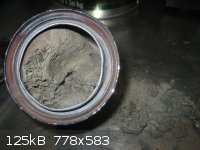 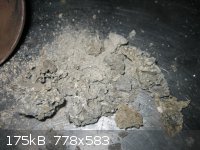
The single most important condition for a successful synthesis is good mixing - Nicodem
|
|
|
learningChem
Hazard to Others
  
Posts: 182
Registered: 21-7-2011
Member Is Offline
Mood: No Mood
|
|
| Quote: | | I concur with watson's assesment that the P is most likely chemically bound as one or more oxides. |
Does that mean that the reaction doesn't work as advertised? Or that (most of) the P is first liberated from the phosphate and then it reacts again
and forms a new P compound?
Also, according to Strepta
"From 3 g of the above mentioned mix, .5 g of P4 is available. The resultant P4 (after re-subliming) weighed .25g or just 50% of theory. "
What's the main difference between your setup and Strepta's? The scale? The shape of the container?
|
|
|
Magpie
lab constructor
    
Posts: 5939
Registered: 1-11-2003
Location: USA
Member Is Offline
Mood: Chemistry: the subtle science.
|
|
It obviously works: white P is produced. It's just not produced in high yield.
These mechanics are not elucidated by our experiments so far. I think it is possible that much of the NaPO3 is left unreacted, probably dissolved in
the glassy silicate.
Quote: Originally posted by learningChem  |
Also, according to Strepta
"From 3 g of the above mentioned mix, .5 g of P4 is available. The resultant P4 (after re-subliming) weighed .25g or just 50% of theory. "
What's the main difference between your setup and Strepta's? The scale? The shape of the container? |
Those, and there are differences in reactant quality and particle size, surely.
The single most important condition for a successful synthesis is good mixing - Nicodem
|
|
|
watson.fawkes
International Hazard
    
Posts: 2793
Registered: 16-8-2008
Member Is Offline
Mood: No Mood
|
|
Quote: Originally posted by Magpie  | | I concur with watson's assesment that the P is most likely chemically bound as one or more oxides. Just where the oxygen originates is a bit of a
mystery |
I didn't emphasize it, but I suspect that the oxides are more properly suboxides. More specifically,
we have full oxides Al2O3, SiO2, and P4O10, with oxidation states Al3+,
Si4+, and P5+. In this hypothetical suboxide matrix, the average oxidation states for each of these elements are simply smaller
than these values. As for the oxygen source, it was the silica and phosphate. There are two suboxides of aluminum Al2O and AlO, with
oxidation state Al+ and Al2+.SiO exists in reduced ceramic phases, with oxidation state Si2+. The phosphite ion has
oxidation state P3+. Any or all of these could be present in some combination, and all of these ions polymerize. It's basically a
partially reduced cement.
The reaction mixture itself, in a sealed can with no external atmosphere, makes a reducing environment. The metallic aluminum ensures that; it acts as
the reducer. The goal is reduce the phosphate, liberating free phosphorus; that happens to a limited extent. But an incomplete reaction means that the
phosphorus only partially reduces, that the silica might reduce, and that the aluminum might not fully oxidize. This seems like it may be the key to
carbothermic reduction of phosphate: the oxidation product of carbon as a gas, its monoxide, does not hinder the formation of a liquid-phase reaction
medium as alumina would.
In any case, this observation is the source of my suggestion to calcine the product slag in moving atmosphere. If it's a suboxide, it should gain
mass. As a qualitative test, also, free P4O10, that is, free of polymeric links to Si and Al, should also form, which could be
detected as a pH change when dissolved in water, as compared to the pH of the slag immediately after the initial reaction.
|
|
|
Strepta
Harmless

Posts: 44
Registered: 6-5-2004
Member Is Offline
Mood: No Mood
|
|
A very interesting thought. Would it be fair to assume that since the complete oxides have larger reaction enthalpies, that the existence of suboxides
implies a shortage of oxygen in the reaction plasma? Does this mean that better mixing may at least, in part, lead to higher yield of the desired P?
@Magpie: I would not be too concerned about the mix igniting in the coffee grinder. It will ignite and burn slowly after being heated to 500C, but as
Blogfast noted several pages up-thread, the reaction enthalpy is just barely positive.
[Edited on 21-9-2012 by Strepta]
|
|
|
watson.fawkes
International Hazard
    
Posts: 2793
Registered: 16-8-2008
Member Is Offline
Mood: No Mood
|
|
Quote: Originally posted by Strepta  | | Would it be fair to assume that since the complete oxides have larger reaction enthalpies, that the existence of suboxides implies a shortage of
oxygen in the reaction plasma? Does this mean that better mixing may at least, in part, lead to higher yield of the desired P? |
Better mixing might lead to a better reaction. The problem is that means reducing particle size, and then you are also
simultaneously removing voids through which gaseous product phosphorus can travel. It seems that the result we're seeing is that firing this reaction
mixture leads principally to suboxide foam unless the P can escape quickly. In this model for what's happening, I'd guess the voids seen in the test
run were initially formed by gaseous P4, which then reacted back into the foam matrix when it couldn't escape.
For the first issue, there's manifestly an oxygen deficit. That's the whole point of the reaction mixture, to have an oxygen transfer from phosphate
to a reducer. This is not a triviality, since it leads immediately to a quantitative issue with the size of the oxygen deficit in the reagent charge.
If aluminum is forming suboxides, it's effective power as a reducer is lowered. One way to deal with that is to triple the amount of Al. That way,
even if it only forms Al2O, with oxidation state 1+, it will scavenge as much oxygen as if the original amount oxidized completely to a 3+
oxidation state. This seems like an easy thing to try, since it doesn't require any new reagents. If the silica is also being reduced, even more Al
would be required.
|
|
|
Magpie
lab constructor
    
Posts: 5939
Registered: 1-11-2003
Location: USA
Member Is Offline
Mood: Chemistry: the subtle science.
|
|
Keep the good ideas coming.
I just finished making some B2O3 from H3BO3. Thank science for coffee grinders. That B2O3 glass is hard as hell.
My next run will be a 50g charge based on the following assumed stoichiometry:
10Al + 6NaPO3 + 6B2O3 ---> 3Na2B4O7 + 5Al2O3 + 6P
My choice of Na2B4O7 (borax) as the end product is somewhat arbitrary. I'm assuming that since it is commonly found in nature it is a stable ground
state.
Note that this requires twice as many moles of B2O3 as SiO2 based on the standard stoichiometry:
10Al + 6NaPO3 + 3SiO2 ----> 3Na2SiO3 + 5Al2O3 + 6P
The single most important condition for a successful synthesis is good mixing - Nicodem
|
|
|
| Pages:
1
..
37
38
39
40
41
..
60 |